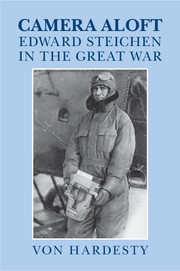Refine search
Actions for selected content:
13588 results in History of science and technology
3 - Panics and scares
-
- Book:
- Toxic Histories
- Published online:
- 05 February 2016
- Print publication:
- 15 February 2016, pp 78-97
-
- Chapter
- Export citation
5 - Intimate histories
-
- Book:
- Toxic Histories
- Published online:
- 05 February 2016
- Print publication:
- 15 February 2016, pp 118-143
-
- Chapter
- Export citation
Copyright page
-
- Book:
- Toxic Histories
- Published online:
- 05 February 2016
- Print publication:
- 15 February 2016, pp iv-iv
-
- Chapter
- Export citation
4 - Toxic evidence
-
- Book:
- Toxic Histories
- Published online:
- 05 February 2016
- Print publication:
- 15 February 2016, pp 98-117
-
- Chapter
- Export citation
6 - Embracing toxicity
-
- Book:
- Toxic Histories
- Published online:
- 05 February 2016
- Print publication:
- 15 February 2016, pp 144-175
-
- Chapter
- Export citation
Contents
-
- Book:
- Toxic Histories
- Published online:
- 05 February 2016
- Print publication:
- 15 February 2016, pp v-v
-
- Chapter
- Export citation
Acknowledgements
-
- Book:
- Toxic Histories
- Published online:
- 05 February 2016
- Print publication:
- 15 February 2016, pp vii-viii
-
- Chapter
- Export citation
1 - The social life of poisons
-
- Book:
- Toxic Histories
- Published online:
- 05 February 2016
- Print publication:
- 15 February 2016, pp 17-40
-
- Chapter
-
- You have access
- HTML
- Export citation
7 - Polluted places, poisoned lives
-
- Book:
- Toxic Histories
- Published online:
- 05 February 2016
- Print publication:
- 15 February 2016, pp 176-208
-
- Chapter
- Export citation
Conclusion
-
- Book:
- Toxic Histories
- Published online:
- 05 February 2016
- Print publication:
- 15 February 2016, pp 209-211
-
- Chapter
- Export citation
Bibliography
-
- Book:
- Toxic Histories
- Published online:
- 05 February 2016
- Print publication:
- 15 February 2016, pp 212-236
-
- Chapter
- Export citation
An experimental ‘Life’ for an experimental life: Richard Waller's biography of Robert Hooke (1705)
-
- Journal:
- The British Journal for the History of Science / Volume 49 / Issue 1 / March 2016
- Published online by Cambridge University Press:
- 15 February 2016, pp. 27-51
- Print publication:
- March 2016
-
- Article
- Export citation
Figures
-
- Book:
- Toxic Histories
- Published online:
- 05 February 2016
- Print publication:
- 15 February 2016, pp vi-vi
-
- Chapter
- Export citation

Toxic Histories
- Poison and Pollution in Modern India
-
- Published online:
- 05 February 2016
- Print publication:
- 15 February 2016

Camera Aloft
- Edward Steichen in the Great War
-
- Published online:
- 05 December 2015
- Print publication:
- 02 December 2015
Appendix: Life at the cutting edge: The photo sections
-
- Book:
- Camera Aloft
- Published online:
- 05 December 2015
- Print publication:
- 02 December 2015, pp 138-150
-
- Chapter
- Export citation
Frontispiece
-
- Book:
- Camera Aloft
- Published online:
- 05 December 2015
- Print publication:
- 02 December 2015, pp xvii-xviii
-
- Chapter
- Export citation
Contents
-
- Book:
- Camera Aloft
- Published online:
- 05 December 2015
- Print publication:
- 02 December 2015, pp vii-viii
-
- Chapter
- Export citation
Copyright page
-
- Book:
- Camera Aloft
- Published online:
- 05 December 2015
- Print publication:
- 02 December 2015, pp iv-iv
-
- Chapter
- Export citation
6 - Over the front
-
- Book:
- Camera Aloft
- Published online:
- 05 December 2015
- Print publication:
- 02 December 2015, pp 109-137
-
- Chapter
- Export citation
